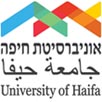The Haifa University Health and Risk Communication Lab is a multidisciplinary center dedicated to the promotion of research, theory and practice in these fields. It was founded in 2016 by Prof. Anat Gesser-Edelsburg. The center's faculty includes researchers from Israel and abroad from different disciplines (epidemiology, nutrition, social marketing, emergency preparedness, health communication, risk communication, health and environment), who research and build multidisciplinary programs.
The center’s objectives
- Advancing theoretical and applied research on health and risk communication through research that makes a scientific and applied contribution to Israel and the world.
- Collaboration with health and environmental organizations and the public to provide research-based practical applied tools and consultation; to adapt their health and risk communication programs to different subpopulations by creating a research-based and culturally-tailored communication between the toorganizations and the public; and to build trust between health and environmental bodies and the public. This will contribute to the physical and mental well-being of the Israeli public, especially during a crisis.
- The development, support and application of health and risk communication programs, as part of position papers, media campaigns and the evaluation of health and risk communication programs, while applying research and theory-based health and risk communication throughout all stages of the programs, including formative research, message design and distribution, and summative evaluation.
- The implementation of a multidisciplinary holistic approach to health and risk communication to create a genuine and profound discourse, through interaction between researchers from different disciplines and content domains, including health, media, epidemiology, nutrition, safety, environment, social marketing, information systems, internet and society, behavior, ethics, management, positions and more.
- Scientific support and training for researchers and graduate students (M.A. and Ph.D.) in health and risk communication.
Key values
- Inclusiveness: including the public in the design, planning and evaluation of health and risk communication programs and campaigns to help create effective collaboration. Inclusiveness between the health organizations, academe and the public will be influential in the following ways: (1) building trust between the healthcare system and the public; (2) customizing programs and media campaigns to the needs of the target population; (3) making academic resources accessible to the players engaged in risk communication on the ground and making the public systems accessible to the public; (4) creating a common, culturally-customized and researched-based language between the public and the health and medical systems.
- Research-based science: implementing strict scientific and research-based standards in the design, planning and evaluation of health and risk communication programs and campaigns by (1) applying empirical studies of risk communication, health communication and the public’s risk perceptions; (2) developing a model of risk communication based on research conducted at the center on a range of subjects, such as providing information on issues involving uncertainty, articulating risk perceptions of different subpopulations, and more; (3) developing and improving research methods that exist in the field today while using diverse methods; and (4) conducting formative research for programs and campaigns designed at the center to help achieve the desired responses.
- Human capital: building a pool of researchers, experts and professionals on communication and health is a national initiative whose results will impact public health in the short, medium and long terms. Building human capital will develop the center's leadership and will be achieved in a number of ways: (1) developing an excellent team of researchers including academic faculty and teaching fellows; (2) encouraging students to write theses and Ph.D.s on health and risk communication; and (3) developing a network of international connections, research partnerships and conferences.


